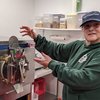Guilderland school district’s draft $98 million budget adds teachers and services
GUILDERLAND — On Tuesday Superintendent Marie Wiles presented a $98.2 million budget proposal for next year, stressing there are no reductions to services or programs. Instead, new teachers will be added and several programs that were cut in recent years are to be restored.
The budget, Wiles told the school board in a televised session, reflected priorities expressed in recent surveys by residents, parents, students, district employees, and board members.
The proposed $98,190,625 budget represents a 1.66-percent increase over this year’s spending plan.
The plan is based on the governor’s aid proposal, and funding could change when the state budget is adopted. The district estimates the tax rate per $1,000 of assessed value for Guilderland residents at $22.60, an increase of 33 cents over this year.
Parts of the school district are located in Bethlehem, where the rate will be $19.88; New Scotland, where the rate will also be $19.88; and Knox, where the rate will be $32.07. Knox has not recently done a town-wide property revaluation.
Salaries and benefits comprise 78.2 percent of the proposed budget for next year. Neil Sanders, assistant superintendent for business, said of education, ‘It’s a people-oriented business.” Fifteen-and-a-half teachers, teaching assistants, and support staff are to be added, as well as an additional four “unassigned” teachers and five “unassigned” teaching assistants. Unassigned posts become assigned as needs arise — for example, if over the summer one of the elementary schools has an unexpected influx of students.
The tax levy for the proposed budget is $71 million, an increase of $1.4 million. The tax levy percentage of 1.97 percent is well below the maximum allowed, of 2.59 percent, which is determined by an eight-step formula set by the state, said Sanders.
Because the percentage is below the tax levy limit, a simple majority would pass the budget on May 16.
Wiles said that this year, for the first time, the district will hold a separate, dedicated question-and-answer session about the budget, on Tuesday, March 14, at 7 p.m. Wiles noted that, for those who cannot attend, questions emailed to the board will be read aloud and answered at the meeting.
Sanders noted that the gap between the proposed levy percentage and the maximum threshold is substantially wider than in past years. He gave the examples of 2016-17, when the increase was 1.35 percent and the limit was 1.37 percent; and 2015-16 when the increase was 2.76 percent and the limit was 2.78 percent. This same pattern could be seen back through 2012-13.
The proposed budget calls for using $300,000 from the district’s fund balance, which is unchanged from the amount used in the 2016-17 budget. Sanders said that the district’s fund balance is “on the right track, going up since 2014-15, after at least four years in which the balance decreased steadily. As of 2015-16 it stood at almost $10 million, the highest it had been in at least six years.
Wiles said that the budget incorporates savings from lower costs for some expenditures, including private-school tuitions, retirement costs, workers’ compensation and unemployment insurance, and fuel. The budget also includes restorations and additions to programs and services based on district priorities, board of education and community input, and recommendations from district leaders, and it continues district efforts to implement inclusionary practices and is mindful of class sizes, Wiles said.
Factors influencing the new draft budget included increases in the state’s foundation aid, which went up $239,000; and in building aid, which went up $160,000. Transportation aid was down, by $149,000.
The governor’s budget proposal includes a proposed $378 million in foundation aid and $333 million in expense-based aids, Sanders said, noting that these amounts still need to be acted upon by the legislature.
Several expenditures were down, including a reduction by $206,000 in costs for students who use Board of Cooperative Education services, or BOCES, or who are placed in private programs to meet special needs. The retirement system costs were down by $723,000, which Sanders said was the result of better performance by investments and the stock market. Workers’ compensation decreased by $175,000, and transfers to the capital fund were down by $897,000.
Health insurance went up substantially, increasing by $1.57 million, which Sanders said was due to a jump in prescription drugs and particularly specialty drugs. Debt payments were also up, by $385,000.
The tax base grew by $869,518, and the allowable growth levy factor, tied to the consumer price index, was $859,141.
The PowerPoint presentation that Wiles made Tuesday night included information about the district’s current budget and size. Last year 72 percent of voters approved the budget, which went up 3.10 percent from the previous year.
Currently Guilderland employs 913 people — 634 work full-time, and 279 part-time — serving a total of 4,818 students.
Projected enrollment for 2017-18 is expected to stay about the same, decreasing by eight students, to 4,810.
What’s new
The district expects to have more foreign students learning English, according to Demian Singleton, assistant superintendent for instruction. The district is proposing one new teacher at the middle school, one new teacher at the high school, and a half-time teacher for Westmere, the elementary school with the highest number of English as a New Language learners.
New state regulations call for teachers to go to students’ classrooms, and ENL students currently meet with a number of different teachers throughout the day; there is “no consistency,” Wiles said. This increase will make it possible, she said, for one teacher to be assigned to each grade, so that teachers get to know individual students.
The high school would see an increase of 3.4 teachers in areas including social studies, Spanish, math academic intervention, physical education, and art, and an increase of two teaching assistants. The middle school would gain 2.9 teachers in areas including Acceleration Algebra 1, Acceleration Living Environment, and math academic intervention.
Elementary school changes include one additional special-education teacher among the five schools to meet with students who have individualized education plans; an elementary school counselor for Pine Bush (the social worker who currently moves between Pine Bush and Lynnwood would be full-time at Lynnwood), a part-time social worker for Altamont and Guilderland elementary schools, and an additional 0.2 faculty in both music and art.
Other areas set for increases include middle-school and high-school co-curricular stipends, school-to-work programs, elementary and middle-school enrichment, and Dutchman Committed, a program that emphasizes clean living. Restored would be junior varsity golf, a weight-room coach, and ninth-grade girls’ basketball.
The football scoreboard would be replaced, at a cost of $15,000, said Wiles who noted, “If you’ve been to a game, you know that sometimes there’s a score, and sometimes there’s not.” She said that the faulty scoreboard reflects poorly on the district.
The district plans to add two permanent daily substitute teachers, which Wiles said would save $23,520 over the current mix of substitutes combined with regular teachers covering for co-workers.
The cost of doing necessary structural repairs to the Cobblestone Schoolhouse — an unused historic building on Route 146 that the district owns, for now — was originally estimated at $30,000, but it has since been found to be $35,000, said Wiles.
The district's administration had several ideas for additional projects that the school board may consider only if more state funds become available. One of them is adding additional resources for professional development.
Another is fixing a broken elevator at Farnsworth Middle School. One of the two elevators at the school does not currently work, Wiles said. It can be a “long journey” to the one working elevator for those who need an elevator, she said. Fixing the second one will cost a projected $150,000.
A third possibility if more state funds become available would be to increase the number of sections in grade seven at Farnsworth from 14 to 16 to allow for further reductions in class size, Wiles said; this will cost $191,000 for 2.5 full-time employees. “If possible, this would be a really positive thing for those students,” Wiles said.
During a public-comment period, town resident Kim Blasiak said that she was standing before the board “as a tired parent,” and pleaded with board members to reconsider a draft plan to cut a certified occupational therapist assistant.
Blasiak said that she understands that the board says it can “get away with five” OT assistants without affecting the services provided to students, but said that parents “breathe a little easier when you know someone’s in the building who sees your kid and not just the diagnosis.” She asked for the current level of staffing in this area to be continued for at least one more year.
Next steps
In addition to the March 14 question-and-answer session, there will be a regular board of education meeting March 21, a budget workshop on April 6. April 11 is set as the date for the board to adopt the budget. From April 12 through May 15, the proposed budget will be discussed with local organizations and parents’ groups. A budget hearing is set for May 2, and the vote is on May 16.
Corrected on March 11 and again on March 13, 2017: In the original story, adding two sections to seventh-grade classes and fixing an elevator at Farnsworth Middle School were described as part of the superintendent’s $98 million budget proposal. Actually, those ideas from the administration may be considered by the school board only if the state provides more funding.

